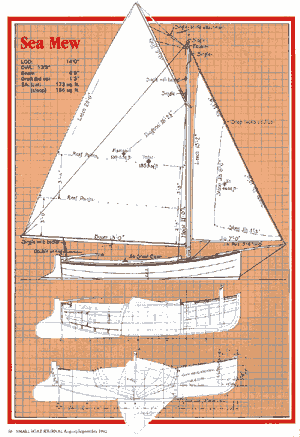The Sea Mew has been designed primarily for what
may be called the kindergarten class. On the Great South Bay,
on Jamaica Bay, on Long Island Sound, and on other pieces of
water, there are many boys and girls under 14 years of age who
are anxious to learn to sail, but whose parents are often timid
about allowing the youngsters to go on the water without some
experienced man being with them.
To keep the sport of yacht sailing alive it is
absolutely necessary that the boys become interested, and the
earlier they learn to sail the more confidence they will gain,
and they will acquire the niceties of boat handling so that
in later years they will be much more skillful than one who
waited until late in life before taking up the sport. The SeaMew
is an absolutely safe boat. It can be rigged as a catboat or
as a sloop. Some prefer the sloop rig, but the best sailors
are those who have graduated from the catboat class.
Several parents who form the summer colony at
Bellport have agreed to build boats from these plans for their
boys. They will be ready for next season. It is very probable,
too, that a similar class will be built for boys or girls on
Moriches Bay. Commodore Effingham Wilson, of the Jamaica Bay
Y.C. is interested in the class and is trying to induce members
of his club to build. The plans have been generally commended
by those who have seen them and they are printed in The Rudder
because it is thought that members of the other clubs will be
interested.
One of the main features of these boats, aside
from their safety, is their cheapness. It has been found absolutely
necessary in promoting small one-design classes to have them
as inexpensive as possible, consistent with good workmanship.
While these boats are of fairly light construction,
the sides being 1/2 inch thick, yet with the lap-strake construction
it will make the boats much stiffer than with heavier planking
of carvel (smooth) construction.
The construction calls for a plank keel 1-1/2
inches thick by 8 inches wide, of oak sprung to shape; bottom
frames sided 7/8 inch and molded 1-1/4 inches at the heel. They
are widened out at the bottom so that the nailing strip for
the chine can be let in the lower end.

(click image to enlarge)
In building the boat, after the molds are all
in, this nailing strip should be let in and temporarily fastened.
The top edge is square; but the lower edge is not beveled off
until all the bottom frames are in so that the correct angles
can be found along its entire length.
The lower edge of the bottom side plank is finished
off square and the bottom planking beveled to fit this. Only
by construction of this sort can a tight job be made of the
chine, for it gives a good seam to calk with something in
back of it.
The decking is light and is covered with a light
canvas - which may be of two pieces with a seam in the middle
- set in a coat of heavy paint on top of the wood deck. There
are two or three ways of fastening the canvas around the cockpit.
It may be turned down inside, and the coaming set against it,
or it can be tacked around the edge and a quarter round molding
fitted in the corner against the coaming, covering the heads.
The former way is the neatest, and if plenty of white lead is
put between, there should not be any leaks along this joint.
The outside edge is tacked along the outside edge of the plank-sheer
and the edge and heads of the tacks covered with the 5/8 inch
by 1-1/4 inch toe rail.
All the rest of the construction is shown plainly
and the various sizes marked, and there is nothing which will
present any difficulties. The mast step extends from the centerboard
trunk to the stem, and the steps should be cut for both rigs
so as to minimize the labor of changing from the cat to the
sloop or vice versa.
The spars are all of spruce — solid —
and can be gotten of clear straight-grained stuff. The mast
for the cat rig should have the heart in the center for strength
as it is practically unsupported except for the headstay.
The sails may be made of about 3 ounce duck,
only if it is desired to have them hold their shape; they should
be either single or double bighted, according to the width of
the cloths, and to have them last, there should be a sail cover,
waterproof, to go on every night.


